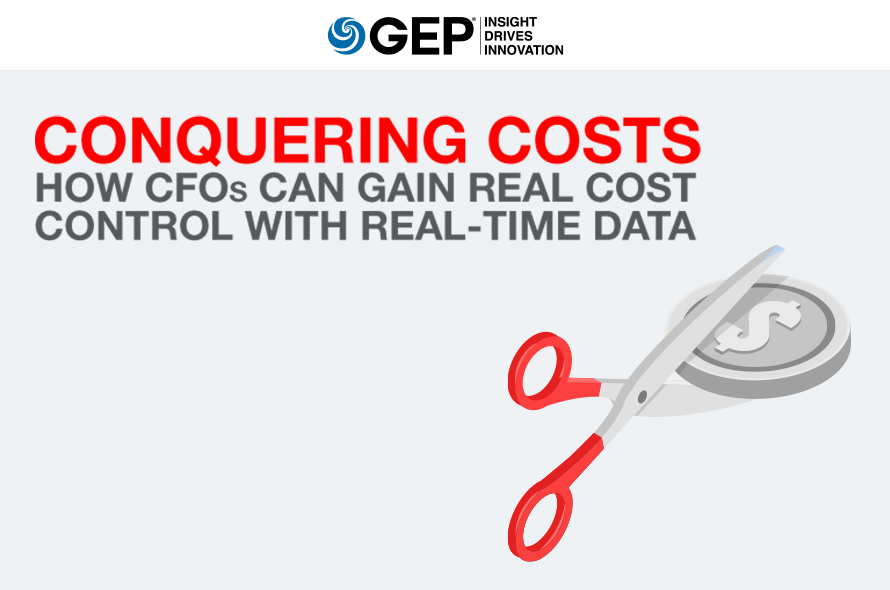Cost-cutting and spend reduction are back at the top of the enterprise priority list. But how are CFOs supposed to implement effective cost-control mandates when their visibility into actual spend data is so poor?
This isn’t a “big data problem” — the obstacle is widely dispersed data and multiple systems of record. CFOs just don’t have the ability to act on spend data in time for their decisions to have real P&L impact. Is there a solution for connecting disparate data sets and driving real-time transparency?
A new GEP Analysis, Conquering Costs: How CFOs Can Gain Real Cost Control with Real-Time Data, explores this problem and suggests ways to create end-to-end spend data visibility, enabling CFOs to make faster and better-informed decisions.
What’s Inside:
- Key factors that have eroded access to company-critical data
- Why dynamic data solutions should be agnostic to systems and user behavior
- How budget-to-pay technology helps procurement and finance gain control of costs
Read now to learn how the right data strategy can foster both true enterprise agility and impactful cost reduction.
CONQUERING COSTS: HOW CFOS CAN GAIN REAL COST CONTROL WITH REAL-TIME DATA
Among all the advice, strategies and ideas being churned out for business leaders right now, the words “flexibility” and “agility” are repeated over and over. Many organizations have made huge progress towards these goals, specifically within functional verticals such as core business operations, supply chain, and sales and marketing. They have done this largely by focusing on digitization and adoption of a data-driven decision-making framework.
One of the indirect consequences of allowing various functions to co-author their digital transformation journey is the proliferation of company-critical data across multiple SaaS platforms and systems. Cloud-based SaaS solutions now account for 30-35% of organizations’ software spending.1 ERPs and IT organizations as the sole gatekeepers of enterprise data are long gone; data is dispersed and there are multiple systems of record. Unified financial controls, as a consequence, suddenly appear to be an impediment to agility and nimbleness.
Let’s view this through the lens of the current situation. A company’s marketing team has been working on a media campaign targeted at the 2020 Olympics; they’ve secured budgets, commenced work on campaign strategies, and engaged media companies to plan their rollout. But then the Olympics are postponed. Budgets are cut, and the marketers are asked to work with procurement to salvage as much cost as possible. And then we leave it to the downstream procure-to-pay teams to sort this out, and that’s where the biggest black box resides.
It is extremely challenging for the CFO to drive a mandate during this crisis because of the inability to act on real-time, end-to-end data, when the window for decision-making is exceedingly short.
The CFO doesn’t see the financial impact of the situation until after the monthly close, which encompasses a host of judgment calls made by finance partners along the way to balance the books. It is at best an approximation, because:
1. Organizations have varying degrees of “No P.O., No Pay” enforcement primarily driven by organizations’ discipline (or lack thereof) to comply with control directives.
2. Three-way match is not diligently set up for all areas of spending because of multiple ERP systems and a proliferation of users (especially for indirect spending).
3. Even for organizations having #1 and #2, getting the P.O.s “right the first time” is extremely challenging, leading to unwarranted journal entries and adjustments.
4. Suppliers do not submit invoices correctly, which leads to after-the-fact corrections and posting issues.
5. The tie-back to the original campaign budget on the campaign management platform is virtually impossible, often maintained in manual spreadsheets.
6. Organizational flux leads to loss of information and knowledge.
So while the CFO may be planning to cut costs rapidly, those plans don’t translate to P&L impact because of the internal bureaucracy built over time, and “continuous improvement initiatives” papering over some of the cracks.
So is real-time visibility for reducing unwanted costs just a myth? Or is it possible to build a pure-play data solution that is agnostic to systems and user behavior? One that just connects the data dots until the end-to-end picture is complete?
Let’s consider the marketing example again:
1. The solution should provide real-time visibility into commitments made to external suppliers for just the Olympics campaign.
2. It should allow the CFO to assess the cancellation’s impact on the Q2 budget with the click of a button.
3. The system of record should then provide a fast-track approval mechanism to direct the freed-up funds toward a new campaign — let’s say, one focused on raising social awareness of COVID-19 and ways to avoid the spread of the pandemic.
4. The CFO should also be able to track the ROI of the reinvested marketing campaign by linking the campaign results (on the marketing software of choice) to the cost commitment (on P.O. systems) to the budget line (on finance’s ERP system) to, ultimately, the cost to deliver that sale.
5. If all the above can be accomplished within a span of, say, a week, the business will be able to operate with much greater agility, and its leaders will have much improved decision-making capability in challenging economic circumstances.
Before we classify it as one of those “Big Data problems,” we should understand that the solution is not about finding a system than can manage massive data. That has largely been solved by cloud service companies and computer manufacturers who have provided super-fast processing machines at low cost.
The solution lies in connecting disparate data sets, driving transparency in real time, and putting the organizational data from multiple systems and functions into perspective. If organizations are able to connect the financial master data with procurement metadata, and then subsequently add the business/operational metadata layer, they will have achieved a dynamic data solution that enables faster and more accurate decision-making.
BUDGET-TO-PAY (B2P): HELPING CFOS WITH SHORT-TERM COST CONTROL
Many organizations are ready to extend the reach of the source-to-pay (S2P) process to budget-to-pay (B2P). B2P will help procurement and finance leverage their respective data to jointly develop cost-control measures instead of simply collaborating on P&L cost reduction impact.
B2P technology can help organizations track every purchasing request against budget lines so that informed decisions can be made before a requisition even comes through the door. Set-up of B2P is straightforward and allows CFOs to differentiate between “good” and “bad” costs with near-surgical precision.
A B2P collaboration between the CFO and CPO allows them to:
1. Prime the organization for better cost visibility by streamlining the chart of accounts and cost controllability rules with finance.
2. Set and revise informed targets, with the ability to ramp up or down; align procurement savings (sustainable, structural reductions) with the budget and add additional demand reductions to reflect current business scenarios.
3. Establish control towers and distribute budgets across various budget owners.
4. Set up a “system of record” for capturing and reporting budgets, actuals, accruals, open commitments, and other provisions; this may require integrating data from multiple third-party software systems and cleansing it for consistency with established rules.
5. Set up an intervention mechanism for each purchasing request and “flex” budgets as needed to reinvest in productive areas.
B2P represents a compelling opportunity for finance and procurement to work together to implement a long-overdue integration of the organization’s massive master data systems to stand up a valuable service for the CFO. It’s no myth; the traditional partnership between procurement and finance can and should evolve beyond siloed process optimization programs to make true enterprise agility and impactful cost reduction a working reality.
RAPID RESPONSE SOLUTIONS FROM GEP
As the coronavirus crisis intensifies, managing your supply chain is going to get even more challenging. It may be worth finding a partner with deep experience in procurement and supply chain management to reinforce your capabilities and help you stay on course.
If you would like to have a conversation about how we can help, please reach out to our supply chain leadership.

Ashwin Kumar
Vice President, Consulting GEP
Ashwin has delivered strategic cost reduction programs for global Fortune 100 clients across CPG, manufacturing, and retail. He has led several digital procurement and supply transformation programs while working closely with finance teams to deliver more than a billion dollars in sustainable EBITDA improvements across multi-year engagements. He specializes in “budget-to-pay,” supply chain optimization, inventory management, organization design, and the deployment of digital best practices for supply management.

